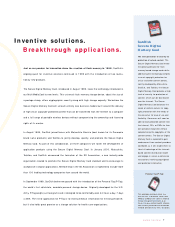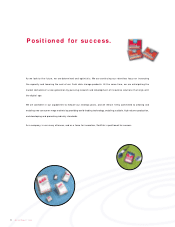SanDisk 1999 Annual Report Download - page 20
Download and view the complete annual report
Please find page 20 of the 1999 SanDisk annual report below. You can navigate through the pages in the report by either clicking on the pages listed below, or by using the keyword search tool below to find specific information within the annual report.
Our assessment and remediation of Year 2000 problems in computer
systems used for facilities control, machine control and manufactur-
ing testing is complete. We are phasing in new Year 2000 compliant
wafer testing equipment in conjunction with the introduction of new
generations of flash memory.
Our assessment of Year 2000 risks related to material suppliers,
customers and other third parties is complete. Inquiries were made
of all critical suppliers and an assessment of their Year 2000 readi-
ness was the basis for strategic decisions regarding alternate
material sourcing and/or increasing inventory safety stocks. We also
attempted to contact our significant customers regarding their Year
2000 readiness in order to understand the potential for any disrup-
tions in their ordering patterns.
YEAR 2000 RISK MANAGEMENT PROGRAM COSTS.
The cost of Year 2000 project related to upgrading our core
management information system was approximately $1.0 million,
$400,000 of which was related to the purchase of software and
hardware which was capitalized. Upgrading application software
and replacing non-compliant personal computer systems cost an
additional $175,000. The majority of these costs would have been
incurred, in spite of Year 2000 issues, due to the need to upgrade
our management information system, application software and per-
sonal computers to support our growth. Our Year 2000 remediation
projects were funded from operating cash flows. No material proj-
ects were deferred in order to complete our Year 2000 assessment
and remediation projects.
RISKS RELATED TO YEAR 200 0 READINESS.
Success of our Year 2000 compliance effort depends, in part, on
the success of our key suppliers and customers in dealing with their
Year 2000 issues. We do not have any control over the remediation
efforts of our key suppliers and customers and cannot fully deter-
mine the extent to which they have resolved their Year 2000
compliance issues. We currently purchase several critical compo-
nents from single or sole source vendors. While this issue is being
carefully managed, disruptions in the supply of components from
any of these sole source suppliers due to Year 2000 issues, could
cause delays in our fulfillment of customer orders which could result
in reduced or lost revenues. Furthermore, our sales have historically
been to a limited number of customers. Any disruptions in the pur-
chasing patterns of these customers or potential customers due to
Year 2000 issues could cause a decline in our revenues. If our key
suppliers and customers have year 2000 problems, our business
could be harmed.
Factors That May Affect Future Results
Our operating results may fluctuate significantly
which may adversely affect our stock price.
Our quarterly and annual operating results have fluctuated signifi-
cantly in the past and we expect that they will continue to fluctuate
in the future. This fluctuation is a result of a variety of factors,
including the following:
•unpredictable demand for our products;
•decline in the average selling prices of our products due to
competitive pricing pressures;
•seasonality in sales of our products;
•adverse changes in product and customer mix;
•slower than anticipated market acceptance of new or enhanced
versions of our products;
•competing flash memory card standards which displace the
standards used in our products;
•changes in our distribution channels;
•timing of license and royalty revenue;
•fluctuations in product costs, particularly due to fluctuations in
manufacturing yields and utilization;
•availability of sufficient silicon wafer foundry capacity to meet
customer demand;
•excess capacity of flash memory from our competitors and our
own new flash wafer capacity;
•significant yield losses which could affect our ability to fulfill
customer orders and could increase our costs;
•lengthening in manufacturing cycle times due to our suppliers
operating at peak capacity;
•increased research and development expenses;
•exchange rate fluctuations, particularly the U.S. dollar to
Japanese yen exchange rate;
•changes in general economic conditions, in particular the
economic recession in Japan;
•natural disasters affecting the countries in which we conduct
our business, particularly Taiwan, Japan and the United States;
•difficulty of forecasting and management of inventory levels;
and
•expenses related to obsolescence of unsold inventory.
17
SanDisk Corporation
MANAGEMENT’S DISCUSSION AND ANALYSIS
























